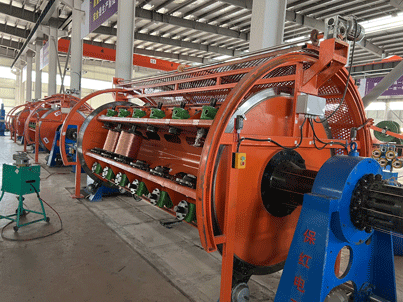What is cable twisting machine?
A cable twisting machine, also known as a cable stranding machine or cable twister, is a specialized piece of equipment used in the cable manufacturing industry. Its primary purpose is to twist multiple wires or cables together to form a composite cable.
Cable twisting machines are essential in various industries that require the production of high-quality cables, including telecommunications, power transmission, automotive, and aerospace sectors. These machines enable manufacturers to produce cables with improved strength, durability, and electrical properties.
What is the main part of a cable twisting machine?
The cable twisting machine consists of several key components that work together to achieve the desired cable structure. Here are the main parts of a typical cable twisting machine:
- Pay-off: The pay-off unit is responsible for unwinding individual wires or cables from their respective supply reels. These wires or cables are then fed into the twisting section of the machine.
- Twisting section: This section houses the twisting mechanisms that twist the wires or cables together. The number of twisting heads depends on the desired cable configuration. Each twisting head holds and rotates the wires or cables at a specific speed and direction to achieve the desired twist pitch.
- Take-up: The take-up unit collects the twisted cable and winds it onto a spool or reel. This section maintains tension and controls the speed of the cable as it is wound onto the take-up reel.
- Control system: The control system of the cable twisting machine is responsible for managing the machine’s operation. It allows operators to set parameters such as twist pitch, rotational speed, and tension. Modern machines often feature computerized control systems for precise and automated operation.
Advantage of cable twisting machine:
Cable twisting machines offer several advantages in the cable manufacturing process.
Firstly, they ensure consistent and uniform twisting, resulting in cables with improved mechanical properties and signal transmission capabilities. The twisting process reduces signal interference and minimizes crosstalk between the individual wires within the cable.
Additionally, cable twisting machines enable the production of cables with higher tensile strength and flexibility. The twisted structure enhances the cable’s resistance to external forces, making it suitable for applications that require robust and durable cables.
Furthermore, cable twisting machines increase production efficiency and reduce labor costs. By automating the twisting process, manufacturers can achieve higher production rates and maintain consistent quality. The precise control systems allow for easy adjustment of parameters, minimizing downtime between cable configurations.
In conclusion, cable twisting machines play a crucial role in the cable manufacturing industry. With their ability to produce high-quality, reliable, and durable cables, these machines contribute to various sectors, including telecommunications, power transmission, automotive, and aerospace. Their precise control systems, uniform twisting capabilities, and increased production efficiency make cable twisting machines indispensable in the modern cable production process.

